
Lucy Jones, scientist and senior warden at St. James’ Church, South Pasadena, leads the diocese’s first Climate Change Summit, held on Sept. 16 at St. Paul’s Commons. (The artwork seen in the background of this and other photos is from “Crossings,” an exhibition of paintings on the theme of refugees by Katharine Gould – a benefit for IRIS, the diocese’s refugee ministry.) Photos: Janet Kawamoto
[The Episcopal News] Moving from fossil fuel to electric energy is crucial for reducing carbon emissions to save the planet and can begin by simply switching appliances, Dr. Lucy Jones told attendees Sept. 16 at the first diocesan Climate Change Summit.
“Buy electric, instead of gas,” advised Jones, a member of the Los Angeles Bishop’s Commission on Climate Change, organizers of the event, which drew about 70 participants to St. Paul’s Commons and another 40 online. “If all of us made a pledge … to make our next car electric, our next stove induction, not gas … we’d meet our emissions goals.”
The summit focused on history, current status, Christian perspective and congregational resources to engage what Jones called “the greatest moral issue facing humanity.”
Describing her own faith journey in the light of her scientific training, Jones asked, “What does God demand of us when we are already looking at what’s happened to the climate?”
“We have very stressed ecosystems,” said Jones, who served for 33 years as a seismologist with the U.S. Geological Survey. She is the senior warden at St. James Church in South Pasadena, one of several congregations creating a program to help congregations prepare for the natural disasters whose frequency is increasing because of climate change. The program will be made available soon, she said.
“Every ecosystem in the world is now receiving a different climate than it evolved to adapt to,” said Jones, the founder and chief scientist of the nonprofit Dr. Lucy Jones Center for Science and Society, which supports the application of science in the creation of more resilient communities. An accomplished musician, she has also launched “Tempo: Music for Climate Action,” a program designed to engage climate scientists, social scientists, and musicians in creating music to inspire action on the climate crisis. Jones shared with the summit a video of a work she composed, titled “”In Nomine Terra Calens: In the name of a warming earth,” based on the rise of Earth’s temperature over the last 138 years (which is as long as such data has been recorded). The video may be viewed here.
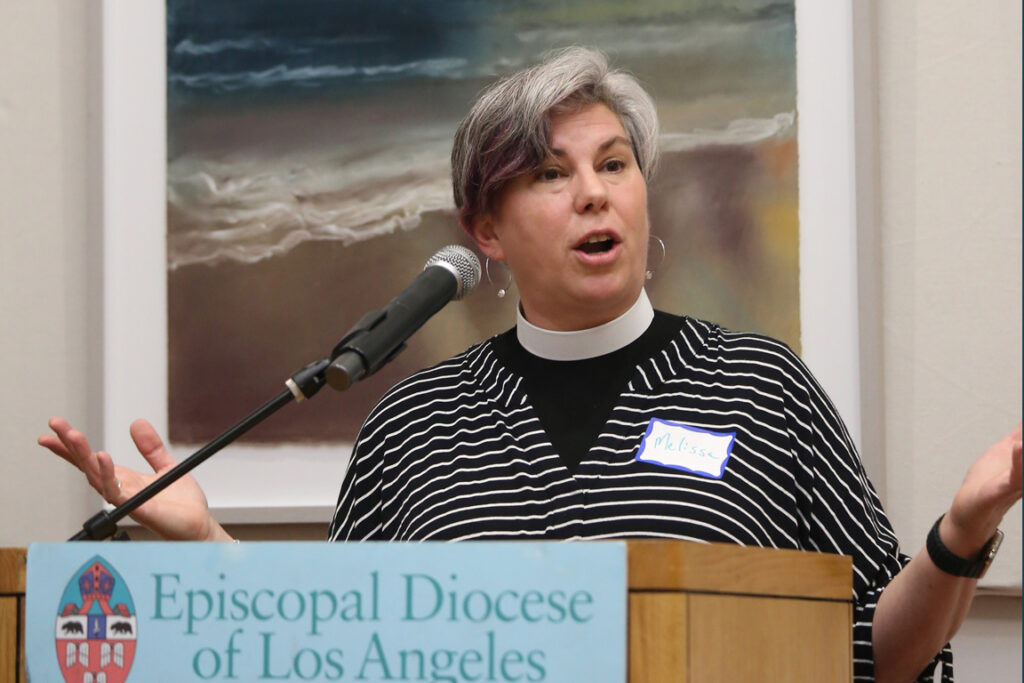
Canon to the Ordinary Melissa McCarthy introduces Lucy Jones as keynote speaker.
Her work on the commission has involved increasing the Episcopal community’s adaptability and resiliency to the dynamic changes of the world around them.
The ongoing Canadian wildfires, along with recent blazes that destroyed Maui’s Lahaina district and flooding in Libya that killed thousands are just the beginning of what will become a worldwide crisis resulting in mass migrations, she said.
It’s already happening in Syria, for example, where delayed rainfall resulted in fewer crops, making some areas uninhabitable because they can no longer sustain food growth.
“It’s not just the civil war that’s driving people out of that region. The potential for real worldwide famine is significant,” Jones said. “Pandemics are a result of stressed ecosystems … There’s one estimate that within 50 years there will be a billion people who will need to choose between moving and dying. How are we going to handle them?”
The commission was launched in March 2022, following a Margaret Parker lecture given at diocesan convention by Mary Nichols, a parishioner of St. James’ in-the-City Church, Los Angeles, and a former longtime chair of the California Air Resources Board. Nichols addressed convention just after her return from the United Nations COP26 meeting in Glasgow, Scotland. Her lecture may be seen on video here; an Episcopal News report is here.
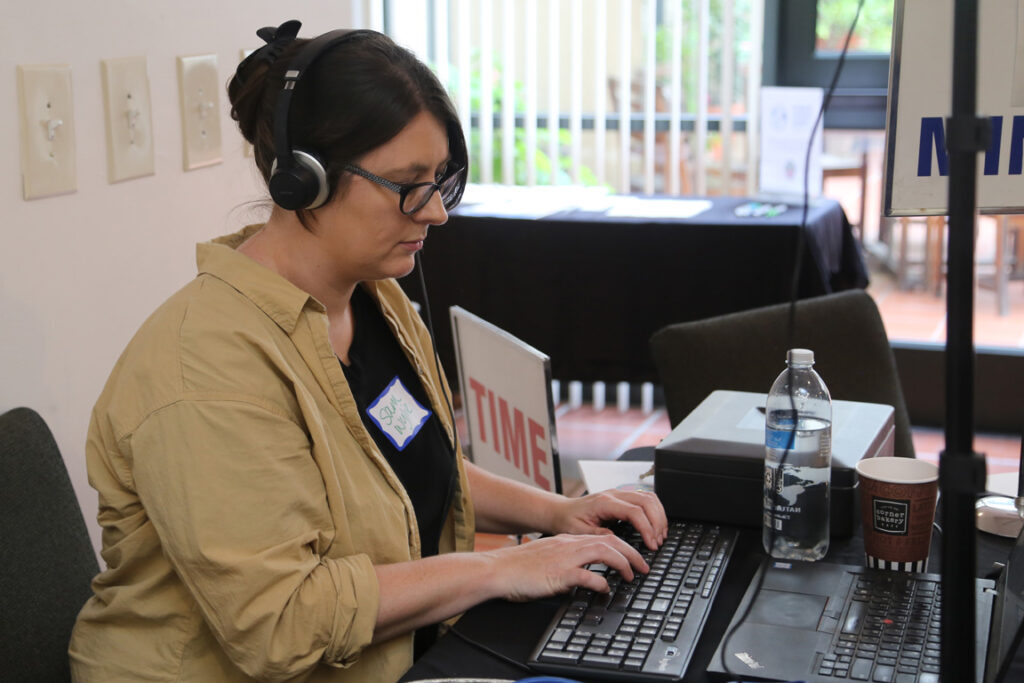
Samantha Wylie, convention coordinator, handles technical aspects of the summit, which was livestreamed on the diocese’s Facebook page and YouTube channel.
Commission priorities include advocacy, education, and preparedness for and responsiveness when natural disasters occur, as well as raising awareness of the intersections of food insecurity and racial justice. A list of commission resources is available on the diocesan website.
Canon to the Ordinary Melissa McCarthy, who chairs the commission, told The Episcopal News that planning is already underway for a second climate change summit, to be held in 2024. “All the presenters were spectacular,” she said. “We have so many great people in our diocese who are involved in climate action. It’s a gift to be able to learn from them. It was an inspiring day!” McCarthy led the planning team for the summit, with administrative support from Samantha Wylie, convention coordinator and member of the diocesan staff.
The full summit may be viewed here.
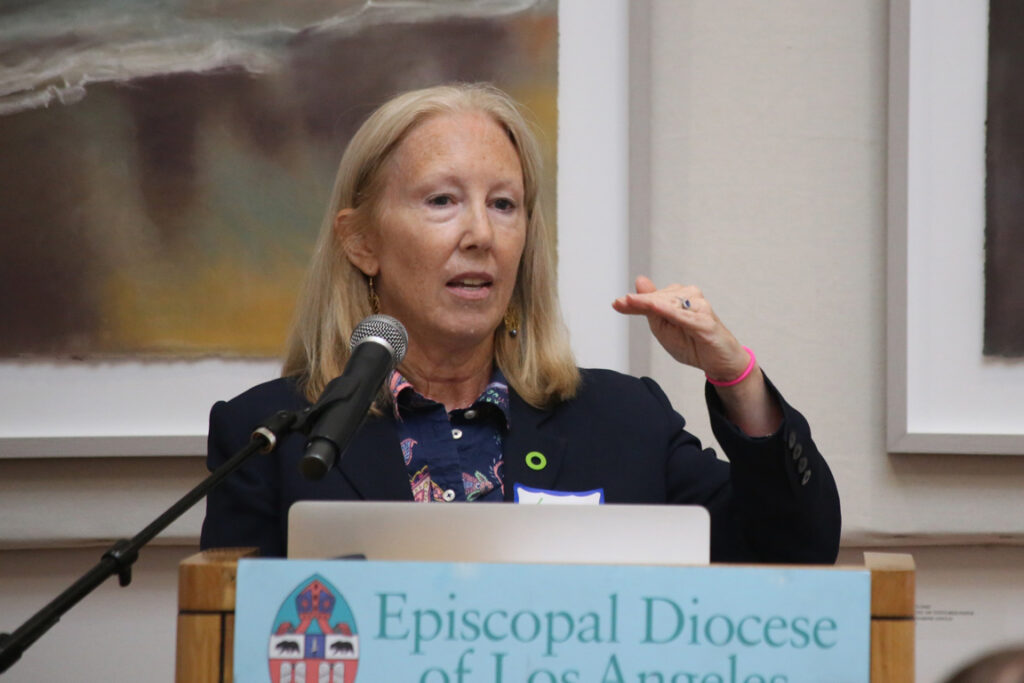
Kate Varley Alonso, a self-described “citizen activist and not a scientist,” shares a “Climate Change 101” video presentation on threats to the planet and ways people can help alleviate them.
Climate Change 101: educational resources
Commission member Kate Varley Alonso, a self-described “citizen activist and not a scientist,” shared a “Climate Change 101” video presentation available for viewing at congregational coffee hours, Sunday school, and adult education forums that illustrates the “fragile and finite nature of the planet we call home.”
Alonso, a member of St. Martin’s in-the-Field Church in Winnetka, co-chairs the commission’s education subcommittee along with Paula Walker. Alonso is also a climate leader with the Climate Reality Project. CRP, an international organization was founded by former Vice President Al Gore, recruits, trains and mobilizes people of all walks of life to work for just climate solutions and to build a sustainable future. Commission members are available to bring the presentation to congregations, Alonso said.
The buildup of greenhouse gas in the earth’s atmosphere is raising the earth’s temperatures and warming oceans to the detriment of marine life. Noting Florida-area water temperatures this year of 101 degrees Fahrenheit, Alonso quoted United Nations Secretary General Antonio Guterres: “The era of global warming has ended; the era of global boiling has arrived.”
Increased warming is the recipe for extreme weather, as evidenced in wildfires in Canada and Maui and flooding elsewhere, she said. According to the National Oceanic and Atmospheric Administration through August of this year, there have been 23 separate weather and climate disasters, each with losses exceeding one billion dollars. “That’s a record for the most disasters in a year, and we still have four more months to go,” Alonso said. “The disasters are happening around the globe. So, we must ask ourselves, are the costs of these extreme events around the world and here at home finally so great that we can say ‘Enough’ and act?”
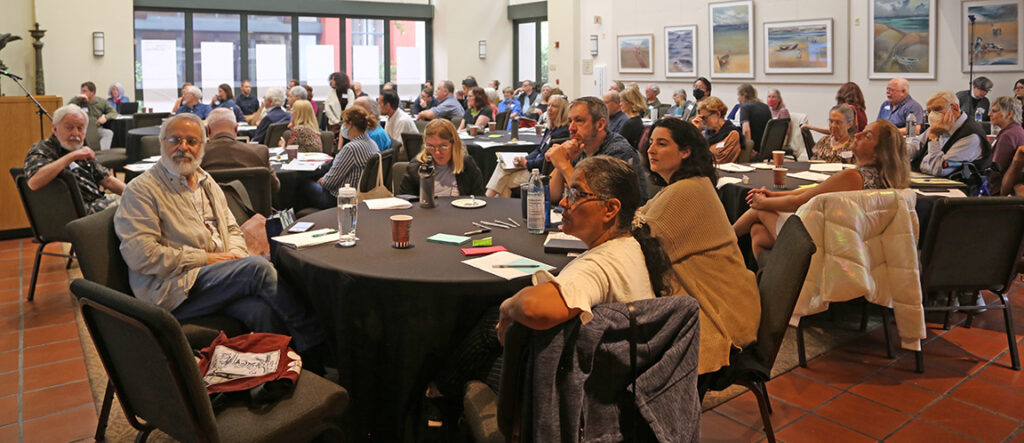
Summit participants watch and listen intently to a video presentation of music based on climate change, composed by Lucy Jones.
But there’s good news, too, she said. “We can solve this. So don’t listen to the naysayers.” Growth in clean energy sources like solar and wind have soared, and technologies “to cut emissions in half by 2030 and keep us on track for net zero by 2050 already exist and the policies that drive their deployment are already proven,” she said.
“Worldwide, carbon free sources generated more electricity than coal or natural gas in 2022 – that is really exciting,” she said.
In the United States, federal spending has increased. “Meet IRA and BIL,” Alonso quipped.
The Inflation Reduction Act (IRA) has allocated $369 billion for energy security and climate solutions, and hundreds of clean energy and climate projects are underway in the public and private sectors.
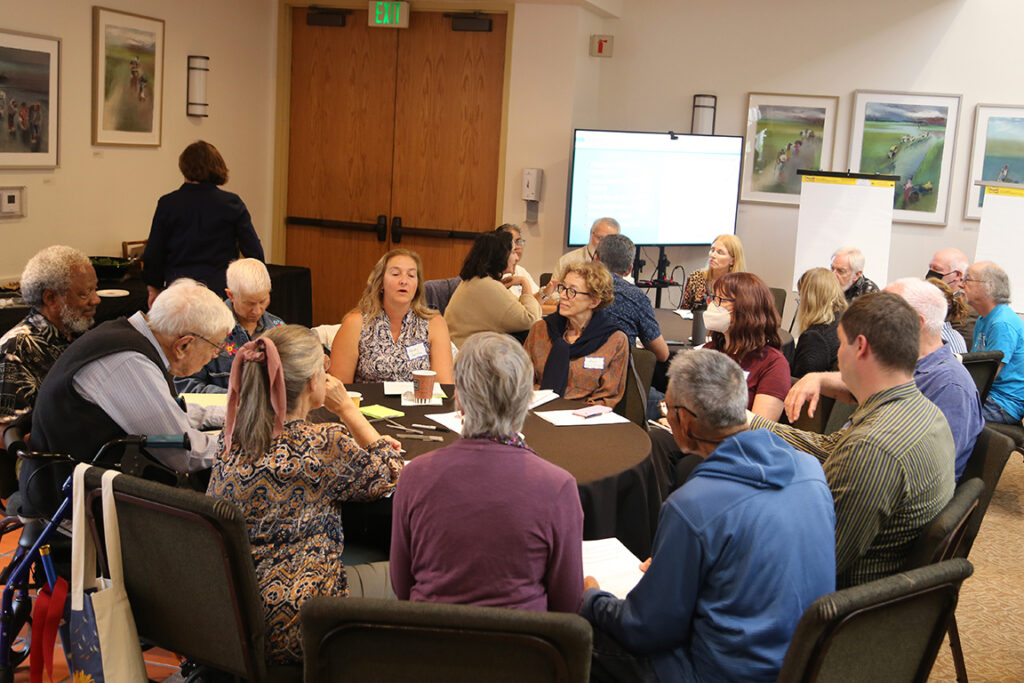
Attendees engage in table discussion during one of several breakout sessions.
The Bipartisan Infrastructure Law (BIL; formally the Infrastructure Investment and Jobs Act, enacted by the U.S. Congress in 2021) allocates $1.2 trillion for infrastructure, including bridge repair and provides for “low-to-no emission public transit, clean school buses, clean water infrastructure, buildout of a national network of electric vehicles, charging stations, ecosystem restoration, wildfire mitigation, flood resistance, and even cleanup of the legacy pollution of all fossil fuel sites,” she said.
Wind projects are expected to triple, and solar projects are expected to increase seven- to eight-fold, she said. Because of the bills, “U.S. federal spending on climate solutions is expected to more than triple.” Concurrently, IRA and BIL could deliver greenhouse gas emissions reductions of about 1 billion tons or 40% by 2030, Alonso said.
Local incentives such as tax credits and rebates are available for individuals and nonprofits. A list is available in the free booklet “Electrify Everything in Your Home,” available at www.rewiringamerica.org, which offers a step-by-step guide to engaging clean energy resources, she said. “If we act and reach true NetZero, global temperatures will stop increasing in three to five years. And about half of our humanmade carbon dioxide will fall out of the atmosphere within 30 years.
“Human caused climate change is going to be human solved climate change,” she said. “Our precious blue marble is counting on us.”
Resources: what can churches do?
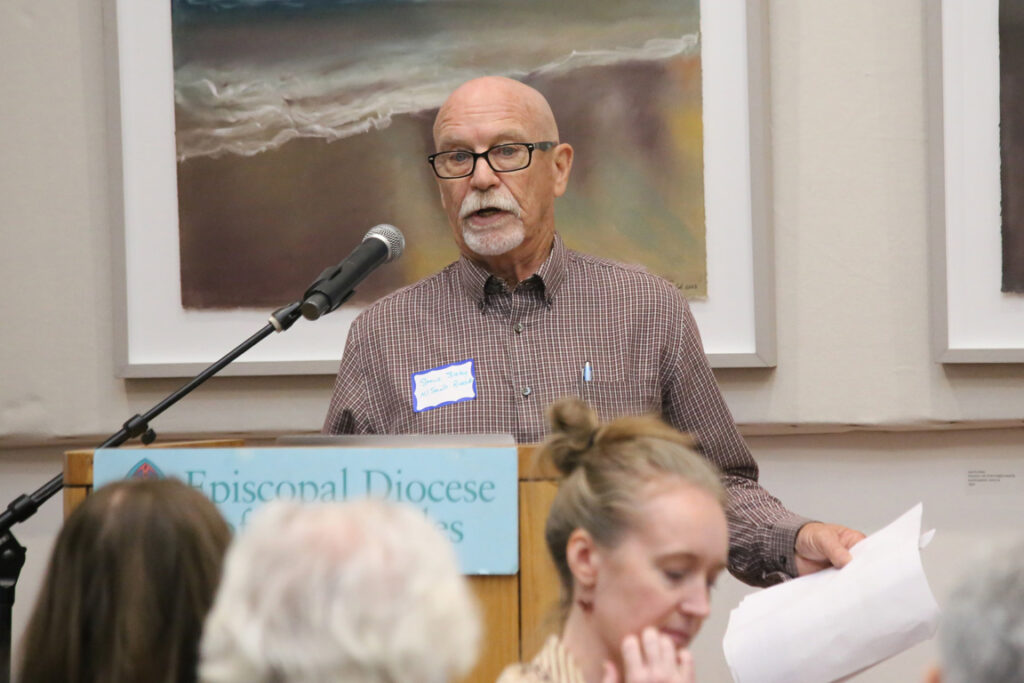
Steve Slaten, junior warden at All Saints’ Church, Riverside, shares some dos and don’ts of installing solar panels, advice drawn from his congregation’s experience.
After a two-year journey “to become electrified” through solar power, All Saints’ Church in Riverside has compiled the congregation’s experiences in a resource that could be helpful to other churches, junior warden Steve Slaten told the gathering.
For example, incorporating solar energy doesn’t necessarily mean adding it to rooftops, he said; if the roof is unable to support a solar array, it might need to be removed and buttressed, creating additional expense. But shade structures with solar panels could be installed over parking lots or play areas, for instance. Considerations before beginning the work involve the orientation and amount of sunlight, selecting appropriate contractors, as well as how to fund such a project. Government tax credits and other funding are possibilities, he said.
The resource document is here. Slaten has offered to serve as a resource for other congregations; he can be reached at juniorwarden@allsaintsriverside.org.
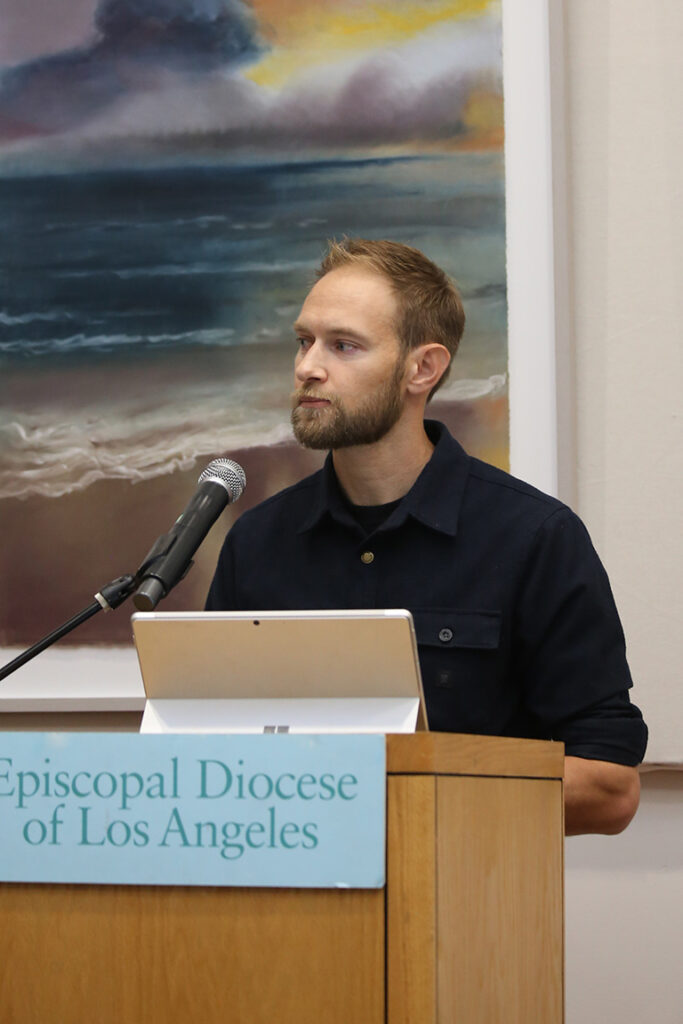
Payton Hoegh, climate commission member and postulant, served as chaplain for the summit and shared resources available to congregations as they seek to combat climate change.
Payton Hoegh, a commission member, recommended “Love God, Love God’s World,” a nine-session film-based curriculum modeled on The Episcopal Church’s racial justice resource, Sacred Ground.
The resource “includes compelling films, poems, readings, along with prayers, faith-based reflections and discussion questions for really rich, transformative small group experiences focused on how we as a church deal with the spiritual crisis that is very much a part of this ecological crisis we face,” said Hoegh who is also the program director for the Center for Spirituality in Nature, an organization offering opportunities for deepening spirituality through nature and for nurturing loving relationships with the Earth.
For example, it includes a training program for finding ambassadors who will equip folks with needed information so that they can share and talk about climate crisis in a way that is educated and accessible.
The Rev. Daniel Tamm, a vocational deacon serving at All Saints Church in Beverly Hills and soon to be joining the staff at St. Michael’s Ministry Center, Riverside, called participants and congregations to advocacy because, he said, “We absolutely do make a difference. Let’s all get engaged in action and let’s make a difference.”
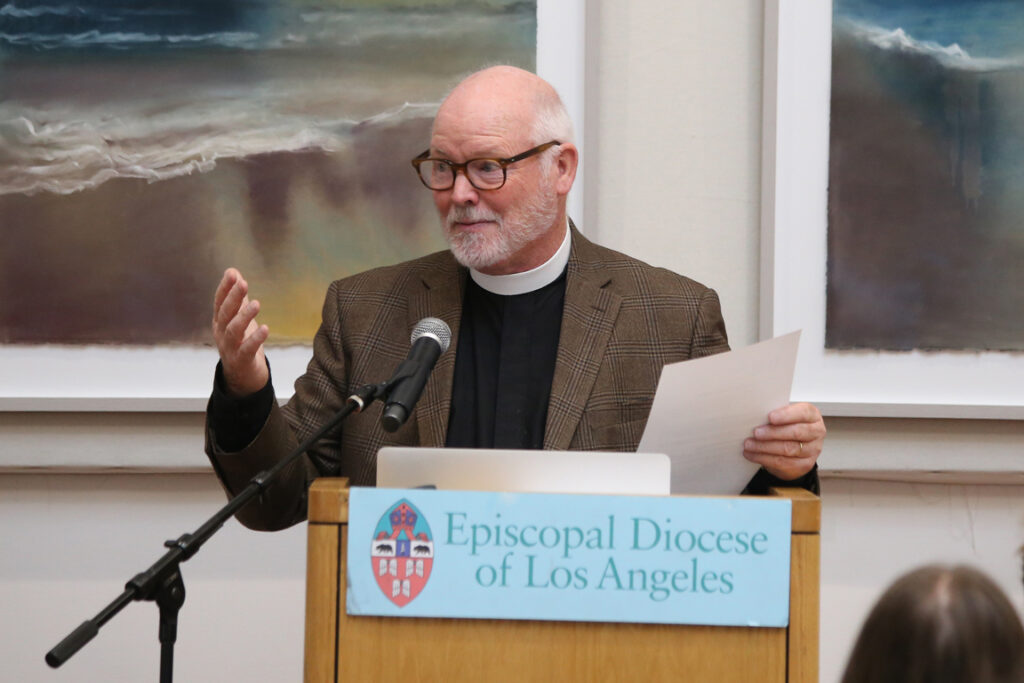
Deacon Daniel Tamm talked about ways that church members can advocate for local, state and national government action to alleviate climate change.
He cited the successful passage of California Assembly Bill 631, which would enforce penalties upon the oil and gas industry for failure to comply with environmental regulations.
Tamm also invited participants to email messages of support for Governor Gavin Newsom’s signing of California Senate Bills 253 and 261, part of the Climate Accountability Package. Newsom has said he will sign the landmark package, which would require companies doing business in California with revenues exceeding $1 billion – such as Amazon, Bank of America and Walmart – to disclose their complete carbon footprint, including greenhouse gas emissions from their suppliers.
Becoming resiliency hubs
Community makes a huge difference when disaster strikes, Jones told the gathering. “I’ve started saying, ‘forget the kit. Talk to your neighbor instead.’”
There is a direct correlation between community connections and disaster recoverability. “Scientists call it social capital. One of the goals of this is to create increased social capital,” Jones said.
There is great opportunity for churches to become resiliency hubs, like cooling centers in extreme heat or warming centers during frigid temperatures, she said. “Excess heat is the deadliest natural disaster in America. Over the last 50 years, we’ve killed more people from excess heat than any other disaster.”
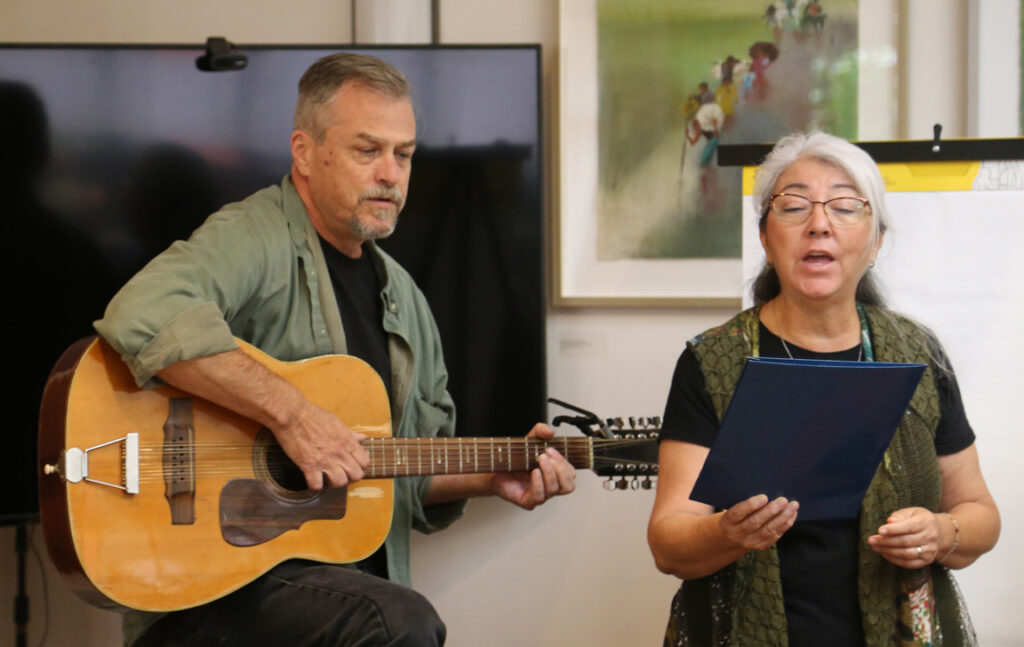
Dave and Sheila Lowerre of St. Andrew’s Church, Fullerton, lead summit participants in music drawing attention to the state of the planet Earth and Christian responsibility for its care.
Church is a place “where we’re already coming together and caring about people,” she said. “But if we want to be there to help our community when things happen, we need to we need to know what we need to do. We need to plan beforehand and make a difference.”
Jones has been working with a cohort of six churches to develop a packet of materials for congregations, focused on such questions as: “Who are we? What do we want to do? What are the disasters we need to face?” she said.
“We’re recommending that everybody start with a communication plan, because you can’t help somebody that you don’t know needs help.” The communication plan should include local community contacts. Parish records, including insurance records, need to be updated and kept in an accessible place, as well as “documented in a digital form so you can get it from anywhere.”
And then we need to start looking at how we can help each other, she said. “How do you relate to the Episcopal parish in the next community over? Are they your competitor for getting parishioners? They can also be partners.”
A second group of churches will be created next year, she said. Interested congregations may contact diocesan Canon for Common Life Bob Williams at bobwilliams@ladiocese.org.
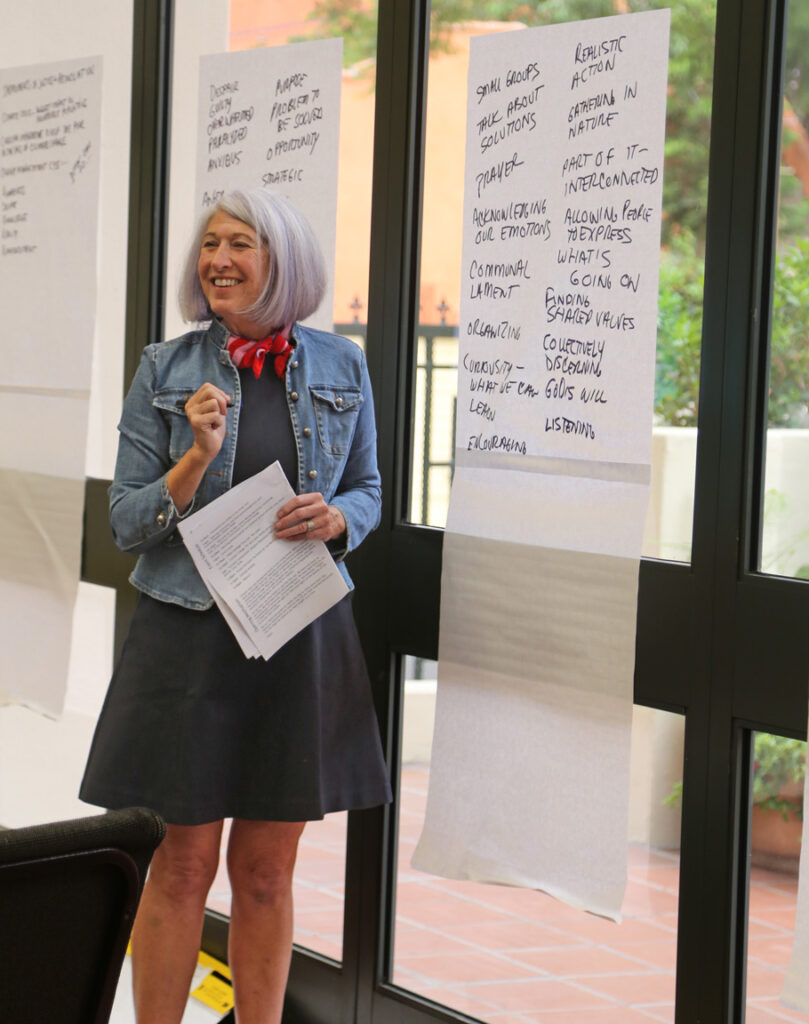
Lisa Markus, cross-cultural consultant, author, and parishioner of St. James Church in South Pasadena, leads a freewheeling whole-group discussion session.
Lisa Markus, cross-cultural consultant and author who is a parishioner of St. James Church in South Pasadena, led a freewheeling whole-group discussion session during which she jotted notes on newsprint.
Markus, whose professional experience includes serving as director of corporate communications for Farmers Insurance, later produced a “Draft Equity Intension Statement” by synthesizing participants’ comments.
“As climate crisis disproportionately impacts vulnerable communities, we are instruments of justice, reconciliation and healing for our world in creating a clean, sustainable future,” the draft reads.
“We listen, engage and involve the communities we serve in climate action so that their emotional, physical, economic and spiritual needs are met and can participate in the challenge.
“Partnering with youth and community trusted voices, we strive to become a resiliency hub – offering emergency relief, connection, renewable power and economic opportunities so that risk and opportunities are equitably shared.”
Marcus has also made available her congregation’s Episcopal Climate Action Road Map as what she calls a “thought starter” for other churches. The Powerpoint presentation may be downloaded here.
